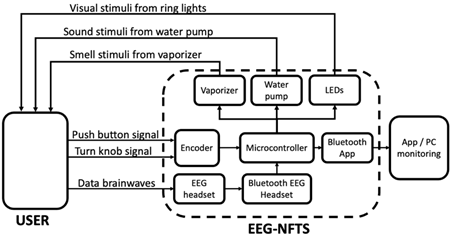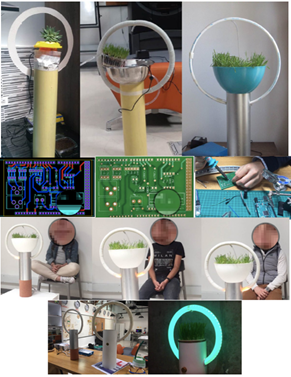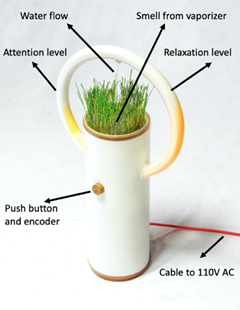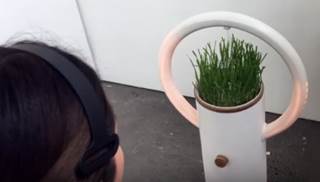I. INTRODUCTION
Over the last thirty years, science has been proving numerous physiological and psychological benefits of the meditation practice [1-3]. One of the most extensive and detailed research on this topic has been carried out by Richard Davidson at Madison University in Wisconsin EU and the Center for Healthy Minds. He and his colleagues have been studying for decades the effects of meditation across a vast number and variety of practitioners. Some research has shown the relation between mental disposition and pain experience [4], the effects of anxiety on the immune system [5], the reduction of cardiovascular risk and healthy aging [6] and how meditation can induce plastic changes in the brain, creating new circuits and new neurons [7]. To develop these studies, researchers have been using neuroimaging technologies such as functional magnetic resonance imaging (fMRI) and electroencephalography (EEG).
German neurologist Hans Berger is considered the father of EEG technology. He created the first device able to record brain wave electrical activity in 1924. Since then, EEG technology has been getting cheaper and smaller. Today it is possible to find a variety of mobile EEG headsets such as the one used in this research. EEG biosensors record the electrical brain activity, specifically the post-synaptic potential, created by some neurons. Groups of more than one thousand neurons can get synchronized and generate different rhythms or frequencies, beta (>13 Hz), alpha (8-13 Hz), theta (4-8 Hz), delta (0.5-4 Hz) which are linked to distinct cognitive function [8]. Laboratories and companies have been studying the correlations between brain activity patterns and different cognitive functions like attention or relaxation and processes as learning and meditation.
Meditation is described as a self-regulatory technique in which the meditator is focused on maintaining attention and reaching a restful state. However, the learning process is not easy for meditators and particularly for beginners because there is no immediate feedback, so they usually do not know if they are doing the activity correctly [9].
Neurofeedback is a non-invasive technique in which the brain itself is responsible of self-regulating the electrical activity that is reflected in the brain waves, based on the feedback stimulus that receives from its own functioning. The feedback stimulus can be visual, auditory, olfactory or tactile, to let the users know their brain activity and become aware of their reactions. Therefore, it generates an increase in the levels of self-control and self-awareness. Neurofeedback training can be done by measuring the electrical activity of the brain with EEG technology and giving some kind of feedback stimulus to the brain.
Researchers have shown that EEG Neurofeedback appears to increase cognitive skills and can be used to support the meditation learning process [10-27]. However, some recent studies found that the benefits from neurofeedback greatly differ between subjects, and in some particular cases neurofeedback does not appear to provide an advantage over meditating on one's own [28,29]. That is why authors [30-33] suggested the use of personalized neurofeedback as a potential way to reduce the inefficacy problem and some other considerations have been shared for the design of a neurofeedback training system.
In this work, an EEG Neurofeedback Training System (EEG-NFTS) is proposed, based on user-centered design methodology to provide real-time performance feedback to meditators to increase attention and relaxation levels through a visual, sound and smell stimuli interface. The system was evaluated by measuring the effects during meditation sessions.
This article is divided as follows: Section 2 presents a description of the methodology, Section 3 presents the design of the EEG Neurofeedback Training System, Section 4 shows the experimental data results and analysis after testing the EEG Neurofeedback Training System, and Section 5 presents the conclusions of the work.
II. METHODOLOGY
The experiment was done in a controlled environment with nine healthy participants ranging from 20 to 35 years old. Five participants were experienced meditators and four participants were non-meditators. The experiment has three stages and participants were evaluated individually. In the first stage, participants were asked to fill in a form with name, age, gender, meditation experience and their current mood based on Pieter Desmet Pick-A-Mood pictorial tool for mood measurement [34]. Cardiovascular variability and arterial pressure were measured using Beurer Electronic Sphygmomanometer. In the second stage, participants were asked to sit in a comfortable position, about 80cm away from the EEG-Neurofeedback Training System and to have 4 individual meditation sessions of 10 minutes each. In the third stage, the current mood of the participants, the cardiovascular variability and arterial pressure were measured to compare data before and after the meditation sessions.
For the second stage, participants were asked to do a meditation session known as Trataka, which is a basic technique for those who begin to meditate and consists in maintaining the eyes opened focusing the eyes on an external object. Participants were asked to focus their eyes in the EEG-NFTS in order to receive the stimuli feedback based on their meditation performance by measuring levels of attention and relaxation with the EEG Neurosky headset.
The first meditation session was without receiving any feedback and the EEG-NFTS was off. In the second meditation session, the EEG-NFTS was giving visual feedback to the participant. In the third meditation session, the EEG-NFTS was giving sound feedback to the participant. In the last meditation session, the EEG-NFTS was giving a bergamot smell feedback to the participant. This means that during the test each participant had a total of 40 minutes of meditation. During the first 10 minutes of meditation the EEG-NFTS was turned off so participants did not receive any stimuli feedback. During the last 30 minutes, participants were interacting with the EEG-NFTS receiving one type of stimuli feedback every 10 minutes.
During each meditation session, attention and relaxation levels were collected from each participant by using the EEG Headset Mind Wave 2 from Neurosky which has a Bluetooth that was connected to receive the data packet frame which contains a 12 bit raw brainwaves (alpha, beta, theta, gamma, delta) with a sampling rate at 512Hz and an integrated data meter for attention and relaxation. The levels of attention and relaxation are given directly from the EEG headset in a scale from 0 to 100 and can be obtained by reading bytes 31-34 from the data frame. The data packet frame is described in table 1.
Table 1 Bluetooth data frame from Neurosky EEG headset
| Byte position | Description |
|---|---|
| 0-1 | Header |
| 2 | Payload length |
| 3 | Signal quality |
| 4 | No poor signal detected |
| 5 | Type of packet |
| 6 | Value length |
| 7-30 | Delta, theta, alpha, beta, gamma bytes |
| 31-32 | Attention level between 0 - 100 |
| 33-34 | Meditation (relaxation) level between 0 - 100 |
| 35 | Checksum |
A. System Design
An EEG Neurofeedback Training System (EEG-NFTS) was designed and implemented to measure the brain activity of the participants using EEG Headset Mind Wave Mobile 2 from Neurosky to obtain attention and relaxation levels during meditation sessions. Levels of attention and relaxation were sent to an App to register the information and to evaluate the incidence of each stimulus in the performance of the participants during a meditation session. Figure 1 shows a block diagram of the EEG-NFTS.
The system contains a microcontroller ATmega2560 that was used to receive and process the brain activity data from the EEG headset to control the actuators and give real-time feedback based on visual, sound and smell stimuli. The actuators from the system are 60 addressable RGB Neopixel LEDs, a 12V water pump and a 12V AC vaporizer. The 60 LEDs were distributed to conform a 35 cm diameter ring. Each half of the ring is composed of 30 LEDS which are turned ON and OFF to indicate the attention (left half of the ring) and relaxation (right half of the ring) levels through a visual stimuli. When the water pump is enabled, the water from a tank flows through a hose that is connected inside the ring to the top so that the water falls back into the tank generating sound. The water flow is controlled automatically by using PWM signals and is proportional to the levels of attention and relaxation. When the vaporizer is enabled, the smell begins to flow if the levels of attention and relaxation are both above 50 on a scale from 0 to 100. All the electronic components were connected in a main circuit board that was designed and installed inside the prototype.
Figure 2 shows some pictures of the design and implementation process to build the final version of the EEG-NFTS system.
Figure 3 shows the EEG-NFTS interface which is composed of an encoder, a visual light ring indicator, a water flow output and a smell output. The encoder works as a button to turn on/off the system and a knob to set up the time duration of the meditation session (during the test participants were not allowed to set the time duration of the meditation session neither choose which stimuli to activate). The cylinder contains the electronic main circuit board, a water tank and a water pump.
To do the test, the system was configured so that only one type of stimuli was enabled per meditation session to evaluate the incidence of each type of stimuli in the performance of the user during the development of the activity. The time duration of each meditation session was set to 10 minutes.
Figure 4 shows a photo of the EEG-NFTS giving visual, sound and smell stimulation feedback to the user to increase the attention and relaxation levels during the meditation session. The left side of the ring is showing an attention level of 75 and the right side of the ring is showing a relaxation level of 50.
III. RESULTS AND DISCUSSION
Levels of attention and relaxation between 0 - 100 were obtained from each participant during a meditation session. The raw data was obtained from the EEG headset and then a moving average filter was applied to show the data in a smoothed curve. Figures 5, 6 and 7, show the attention and relaxation levels of the participants while receiving real-time feedback during the meditation sessions for each kind of stimuli. The black curve shows the attention levels without receiving any stimuli. The green curve shows the attention levels with visual (light) stimuli. The blue curve shows the attention levels with sound (water) stimuli. The red curve shows the attention levels with smell stimuli.
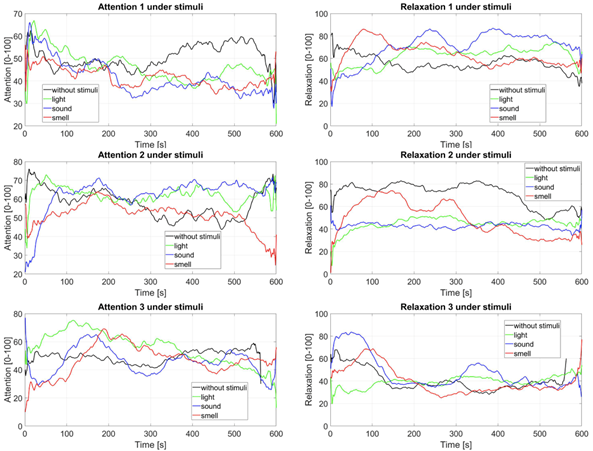
Fig. 5 Attention and relaxation levels from participants #1, #2 and #3 during meditation session with different kind of stimuli.
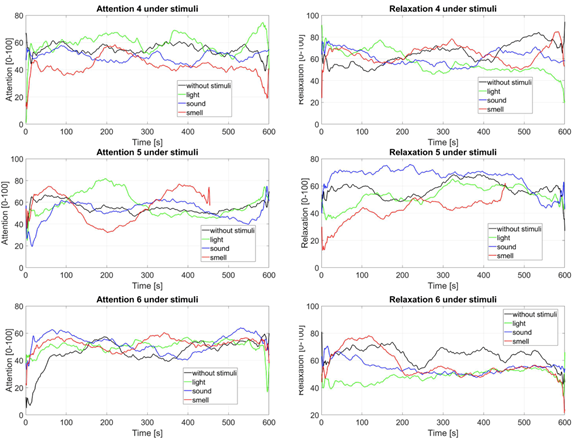
Fig. 6 Attention and relaxation levels from participants #4, #5 and #6 during meditation session with different kind of stimuli.
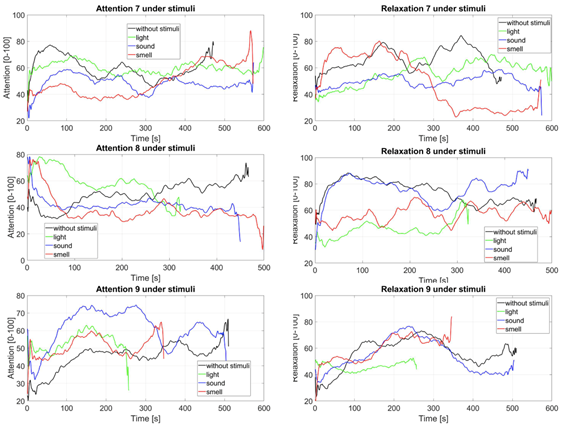
Fig. 7 Attention and relaxation levels from participants #7, #8 and #9 during meditation session with different kind of stimuli.
Table 2 and Table 3 shows the average levels of attention and relaxation respectively of each participant during the meditation session. Table 4 shows the data collected from each participant at the beginning and at the end of each meditation session.
Table 2 Average attention levels for each participant during a meditation session
Table 3 Average relaxation levels for each participant during a meditation session.
Table 4 Data collected at the beginning and at the end of each session for each participant.
| # Participant and Experience | Mood at the Beginning | Mood at the End | Arterial Pressure at the Beginning | Arterial Pressure at the End |
|---|---|---|---|---|
| 1. practitioner | Excited- Lively | Cheerful - Happy | 99/66 - 86ppm | 95/58 - 70ppm |
| 2. practitioner | Cheerful - Happy | Relaxed- Carefree | 110/74 - 80ppm | 113/74 - 75ppm |
| 3. practitioner | Excited - Lively | Relaxed - Carefree | 121/85 - 88ppm | 125/100 - 74ppm |
| 4. non-practitioner | Excited - Lively | Relaxed - Carefree | 124/56 - 78ppm | 120/70 - 66ppm |
| 5. practitioner | Cheerful - Happy | Excited - Lively | 105/70 - 90ppm | 110/74 - 80ppm |
| 6. practitioner | Irritated- Annoyed | Calm - Serene | 120/76 - 103ppm | 133/78 - 81ppm |
| 7. non-practitioner | Cheerful - Happy | Excited - Lively | 124/81- 78ppm | 129/106 - 74ppm |
| 8. non-practitioner | Irritated- Annoyed | Cheerful - Happy | 132/76 - 87ppm | 125/82 - 85ppm |
| 9. non-practitioner | Excited - Lively | Cheerful - Happy | 125/80 - 85ppm | 124/75 - 80ppm |
These results show that the visual stimuli feedback was able to increase the average attention levels of 78% of the participants by 11.8% compared to a meditation session without any feedback. The sound stimuli feedback was able to increase the relaxation levels of 44.4% of the participants by 16% compared to a session without any feedback. The visual stimuli feedback has a positive impact on the attention levels but reduces the relaxation levels of the 88.9% of the users by 19.9%. Smell stimuli feedback was only able to increase the average attention and relaxation levels of 33.3% of the participant by 9.9% and 7.3% respectively. The smell stimuli feedback reduced the average attention and relaxation levels of 66.6% of the participants by 16% and 20% respectively.
Participants that are practitioners obtained lower levels of standard deviation for attention compared to participants who are non-practitioners. This means that non-practitioners are more sensitive to variations of their attention levels during a meditation session while receiving different stimuli feedback. Standard deviation levels for relaxation were similar for both practitioners and non-practitioners. This means that all the participants are more sensitive to variations of their relaxation levels during a meditation session while receiving different stimuli feedback.
Following the self-reported mood, one can deduce that at the beginning of the test most participants felt excited-lively. At the end of the test, most participants felt cheerful-happy and relaxed-carefree. This resonates with the biometric measurements taken at the beginning and at the end of the test in which most participants show a decrease in both, pulse variability and arterial pressure, this behavior is directly related to low anxiety and high wellbeing. These results show that different stimuli feedback can improve the meditation performance of the practitioners by increasing attention and relaxation levels leading to a desired mindful state.
IV. CONCLUSIONS
An EEG Neurofeedback training system (EEG-NFTS) was proposed to increase attention and relaxation levels during a meditation practice by giving real-time feedback to the user through visual, sound and smell stimuli. The system was validated with nine participants by using a Neurosky EEG headset to measure attention and relaxation levels during meditation practice to evaluate the incidence of each stimulus in the performance of the activity. The visual stimuli feedback was able to increase the average attention levels of 78% of the participants by 11.8% compared to a session without any feedback. The sound stimuli feedback was able to increase the average relaxation levels for 44.4% of the participants by 16% compared to a session without any feedback. The visual stimuli feedback has a positive impact in attention levels but reduces the relaxation levels of the 88.9% of the users by 19.9%.
The system has a greater impact on the average attention levels of the inexperienced meditators during a meditation session, so it can be useful during the meditation learning process.
The smell stimuli tend to reduce the average attention and relaxation levels of the participants. However, smell feedback was not clear for the participants because even if the vaporizer is turned on and off the aroma will still be in the air.
Further research with a larger number of participants is required to validate the effects of real-time feedback based on the proposed stimuli interface. The system was designed so that it can be used to give real-time feedback to the participants during a meditation session by using one or more stimuli at the same time. It is important to analyze how participants respond to multiple stimuli feedback at the same time because by combining different stimuli it could be possible to increase attention and relaxation levels simultaneously.














